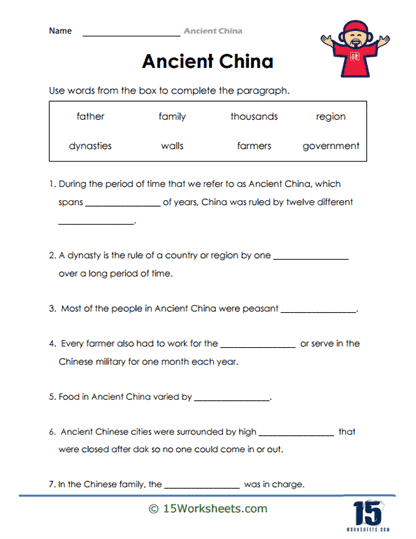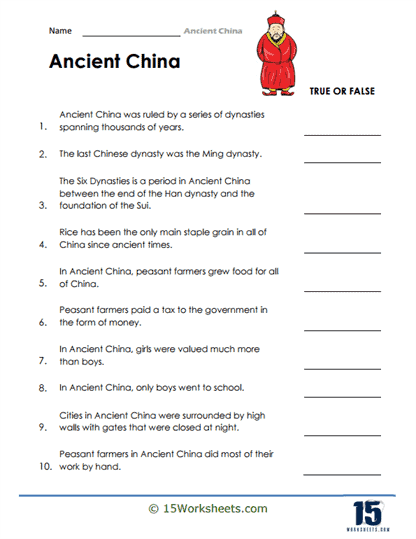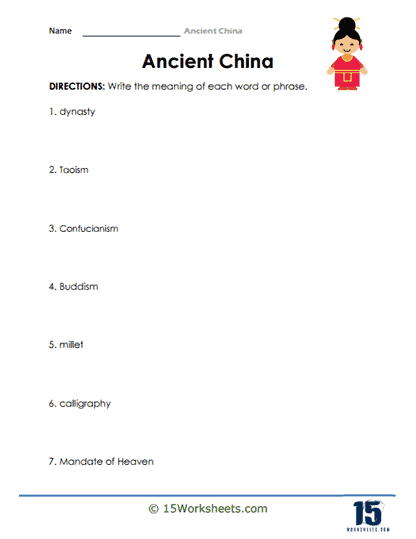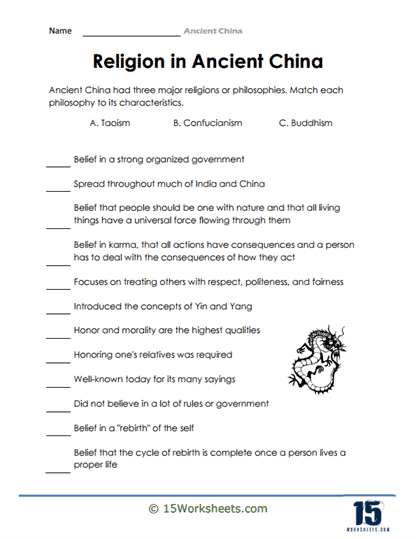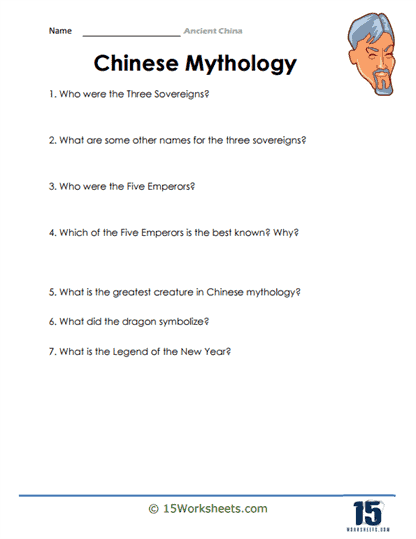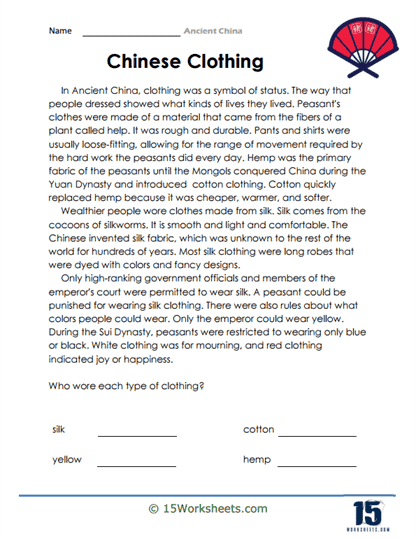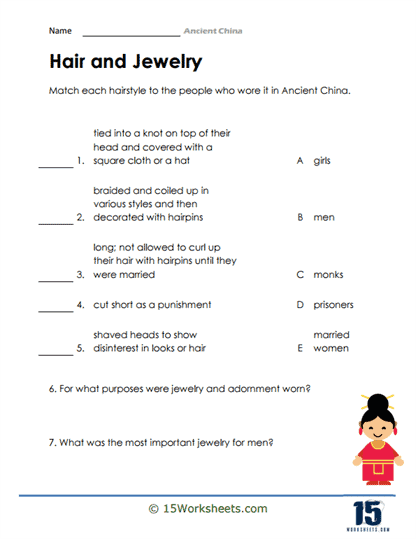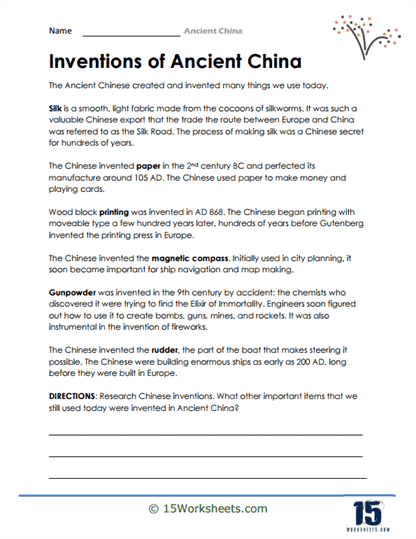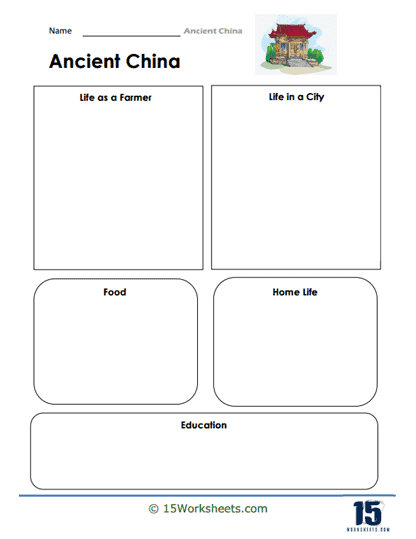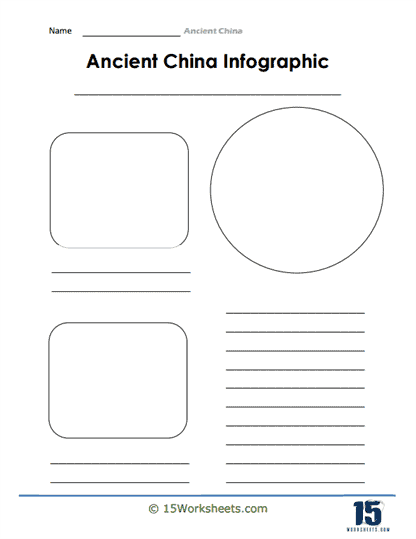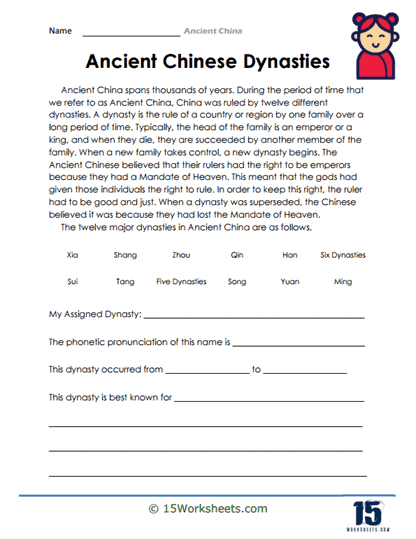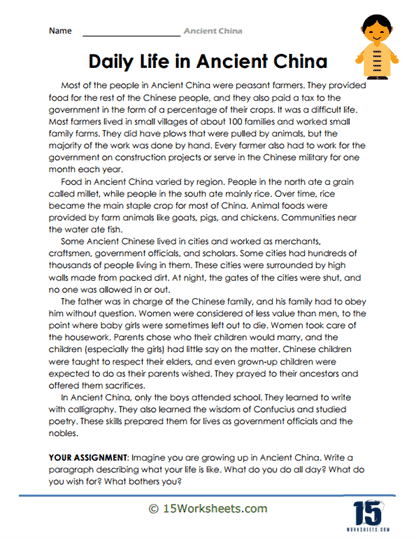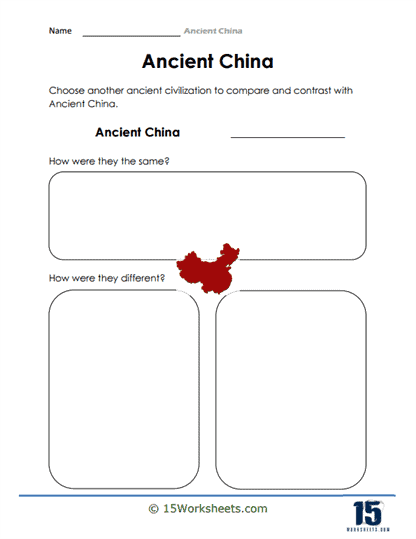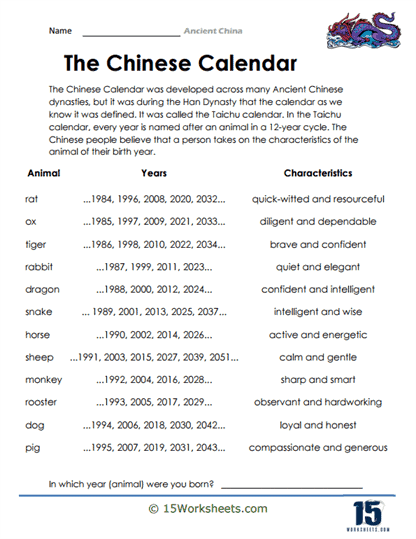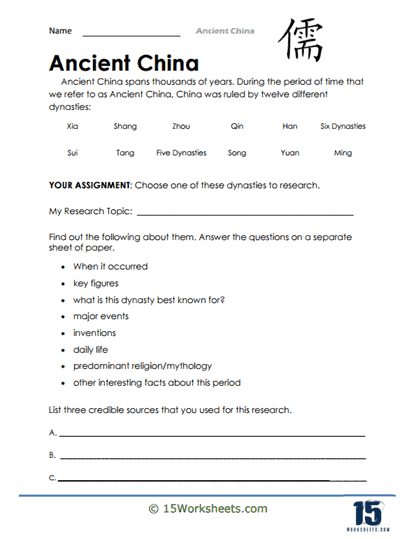Ancient China Worksheets
All About These 15 Worksheets
Students embark on a transformative journey through the captivating history and vibrant culture of Ancient China with this thoughtfully curated series of 15 worksheets. Each worksheet is designed not only to educate but also to spark curiosity and deepen understanding of one of the world’s most influential ancient civilizations. This comprehensive collection covers a wide array of topics, offering students the opportunity to explore Ancient China’s rich heritage in a way that is both engaging and intellectually stimulating.
This series of worksheets does more than just present historical facts; it immerses students in the daily life, beliefs, and innovations of Ancient China, encouraging them to connect with the past on a deeper level. With each activity, students are invited to step into the shoes of historians, philosophers, and inventors as they delve into a diverse set of tasks, ranging from reading comprehension exercises to creative projects and research-based inquiries. The structured, yet flexible nature of the worksheets ensures that students not only absorb information but also critically engage with the material, making their learning experience both meaningful and memorable.
Through fill-in-the-blank activities, students can showcase their understanding of Ancient China’s key events, figures, and societal structures. These exercises are not simply rote memorization but an invitation to reflect on the intricate details that made this civilization so unique. Moreover, by evaluating the accuracy of statements and defining key terms and concepts, students are challenged to think critically, fostering a deeper comprehension of the complex ideas that shaped Ancient Chinese thought and governance. These tasks enable learners to engage actively with historical analysis and sharpen their interpretative skills.
A particularly intriguing aspect of this collection is the focus on the major religious beliefs and philosophies that influenced Ancient Chinese society. Students are encouraged to explore the distinct yet interconnected traditions of Confucianism, Daoism, and Buddhism, understanding how these belief systems shaped not only spiritual life but also politics, ethics, and daily customs. This comparative study helps students appreciate the diversity of thought that characterized Ancient China and provides them with tools to recognize the impact of these philosophies on both ancient and modern societies.
Mythology plays an equally crucial role in understanding the cultural identity of Ancient China, and students will have the chance to demonstrate their knowledge of Chinese mythology through writing prompts. By interpreting and analyzing myths, students can see how stories of gods, heroes, and legendary figures helped to convey moral lessons, explain natural phenomena, and unify communities across the vast Chinese empire. This component of the worksheets taps into students’ creative thinking, encouraging them to draw connections between mythology and broader historical themes.
Students will gain an appreciation for the aesthetic and material culture of Ancient China through activities that explore Chinese clothing, hairstyles, jewelry, and significant inventions. By reading passages, answering thought-provoking questions, and conducting further research, students are not only exposed to the surface-level facts about fashion and innovation but are also led to understand the underlying social and cultural values that informed these practices. Whether it’s the silk garments that signified social status or the groundbreaking technological advancements that transformed the world, these worksheets offer students a holistic view of Chinese ingenuity.
Daily life in Ancient China comes alive as students dive into reading passages that depict everything from the bustling streets of imperial cities to the intimate details of family life in rural villages. Responding to prompts about these passages allows students to synthesize historical information with empathy and imagination, bringing history to life in a way that feels personal and relatable. This deeper connection to the past fosters not only an intellectual understanding but an emotional resonance with the people who lived during this remarkable period.
To round out their exploration, students will create detailed infographics that summarize their findings and research. This project allows them to visually organize and present their knowledge, reinforcing what they have learned while also encouraging creativity and independent thought. By designing these infographics, students move beyond passive learning to become active participants in their own educational journey.
An in-depth exploration of the 12 dynasties of Ancient China will sharpen students’ research skills and give them a strong foundation in Chinese political and social history. This comprehensive task encourages independent inquiry, allowing students to dive deeper into topics of personal interest while developing their ability to synthesize large amounts of information into clear, cohesive narratives.
The Significance of Ancient China
Ancient China made several significant advancements in various fields, including science, technology, agriculture, medicine, and philosophy. Here are some of the biggest advancements of ancient China:
- Papermaking – The invention of papermaking is one of the most significant advancements in Chinese history. Cai Lun, a court official, is credited with inventing paper around 105 AD. The invention of paper revolutionized the way information was recorded and transmitted.
- Printing – The Chinese also developed printing technology. They used carved wooden blocks to print books as early as the 7th century AD. In the 11th century, Bi Sheng invented movable type, which made printing even more efficient.
- Gunpowder – Chinese alchemists discovered gunpowder in the 9th century AD. Although initially used for fireworks, gunpowder was eventually used in weapons, which revolutionized warfare.
- Compass – The invention of the compass allowed for more accurate navigation at sea. The Chinese invented the compass in the 2nd century BC.
- Silk Production – The Chinese were the first to produce silk, which was a highly valued commodity. The Silk Road, a network of trade routes that linked China to the Middle East and Europe, was established in the 2nd century BC to transport silk and other goods.
- Agricultural Techniques – The Chinese developed several agricultural techniques, including crop rotation, irrigation systems, and the use of fertilizers. These advancements increased crop yields and allowed for more food production.
- Medicine – The Chinese made significant advancements in medicine, including the use of herbal remedies, acupuncture, and moxibustion. They also developed a sophisticated system of diagnosis and treatment.
- Philosophy – Ancient China was home to several important philosophical schools, including Confucianism, Taoism, and Legalism. These schools of thought had a profound impact on Chinese culture and society.
Ancient China made many significant advancements that have had a lasting impact on the world. Their contributions to science, technology, agriculture, medicine, and philosophy continue to influence modern society today.
Key Periods in Ancient China
The progression of ancient China spans over a long period, from the prehistoric period to the end of the Han dynasty in 220 AD. Here is a brief overview of the key periods and developments in ancient China:
- Prehistoric Period – The prehistoric period in China is characterized by the development of agriculture and the emergence of early cultures such as the Yangshao and Longshan cultures.
- Xia Dynasty – The Xia dynasty was the first recorded dynasty in Chinese history, and it is believed to have ruled from around 2100 BC to 1600 BC. Little is known about the Xia dynasty, and some scholars consider it a myth.
- Shang Dynasty – The Shang dynasty was the first dynasty to leave written records, and it ruled from around 1600 BC to 1046 BC. The Shang dynasty was characterized by a centralized government, a complex social hierarchy, and the development of bronze metallurgy.
- Zhou Dynasty – The Zhou dynasty ruled from around 1046 BC to 256 BC and is divided into two periods: the Western Zhou and the Eastern Zhou. The Zhou dynasty was characterized by the development of feudalism, the introduction of iron metallurgy, and the emergence of Confucianism and Taoism.
- Qin Dynasty – The Qin dynasty ruled from 221 BC to 206 BC and was the first dynasty to unify China under a centralized government. The Qin dynasty is known for the construction of the Great Wall of China, the development of a legalist philosophy, and the establishment of a standard system of weights and measures.
- Han Dynasty – The Han dynasty ruled from 206 BC to 220 AD and is divided into two periods: the Western Han and the Eastern Han. The Han dynasty was characterized by the development of papermaking, the construction of the Silk Road, the invention of the seismograph, and the emergence of the Silk Road. The Han dynasty also saw the development of Confucianism as the dominant philosophy and the emergence of Taoism as a popular religion.
In summary, the progression of ancient China was marked by a series of dynasties that saw the development of sophisticated cultures, advanced technologies, and complex philosophical and religious systems. These developments have had a lasting impact on Chinese society and culture, as well as on the world at large.

